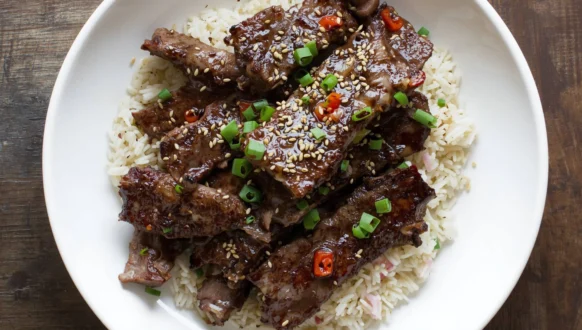How To Make A Flavorful Korean Beef Recipe (Bulgogi-style)
Welcome to your go-to guide for a flavorful Korean beef recipe. If you’ve ever wanted a crowd-pleasing dinner that’s quick to pull together yet deeply satisfying, you’ve found it. This Bulgogi-style beef delivers a balanced savory-sweet marinade, a bright sesame aroma, and a sizzling finish that caramelizes beautifully in a hot pan. In this post, you’ll learn exactly what makes this Korean beef recipe so flavorful, how long it takes from pantry to plate, and smart serving ideas that pair perfectly with rice, kimchi, and quick veggie sides. Whether you’re meal-prepping for the week or cooking a weeknight supper, this guide keeps things simple, efficient, and delicious—no guesswork required.
What makes this Korean beef recipe flavorful
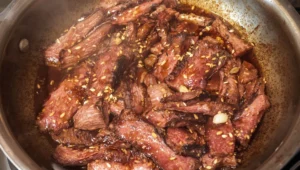
Tender Korean beef ribs with sesame glaze over steamed rice
Subtopic 1: Core flavor pillars
Marinade balance: The hallmark is a harmonious balance of savory, sweet, and umami. Think a base of soy sauce for depth, a touch of brown sugar or honey for caramel sweetness, and a kiss of sesame oil for nutty richness. This trio creates a glossy glaze that clings to every slice.
Aromatics that lift the dish: Fresh garlic and ginger bring warmth and brightness, while a splash of onion adds subtle sweetness. If you want extra lift, a small amount of minced green onion added toward the end delivers a fresh, peppery finish.
Sesame aroma and crunch: Toasted sesame seeds sprinkled on top or stirred into the final plate provide both aroma and a gentle crunch that enhances the overall tasting experience.
Maillard magic: A hot skillet or grill reaches high temperatures quickly, allowing a rapid sear that caramelizes sugars and browns the surface, producing a savory crust and complex flavor depth without overcooking the beef.
Texture contrast: Thinly sliced beef or small, uniform pieces sear evenly and stay tender when rested briefly after cooking, ensuring a juicy bite with every mouthful.
How to emphasize these pillars in practice: Use a marinade that hits all three pillars (savory, sweet, umami); finish with a hot sear to develop browning; finish with a brief rest and a light drizzle of sesame oil or a scatter of sesame seeds.
Subtopic 2: Bulgogi-style technique explained
Why Bulgogi-style matters: Bulgogi is defined by a thin-cut beef and a marinade that deeply flavors the meat while preserving a delicate, tender texture when cooked quickly. Recreating that approach in a home kitchen yields restaurant-like depth with approachable technique.
Thin slicing and equilibrium: Slice beef evenly to ensure uniform marination and cooking. Even thickness helps the marinade penetrate thoroughly and prevents overcooking edges while the center remains underdone.
Marinade depth and ingredient roles:
Soy sauce provides salt and umami backbone.
Sugar or honey balances salt with sweetness, enabling a glossy glaze.
Sesame oil adds aroma and a nutty finish that ties the dish together.
Aromatics (garlic, ginger) deliver warmth without overpowering the beef.
Pear or apple juice (or grated pear) acts as a natural tenderizer and helps create a tender, juicy texture while contributing a subtle fruit sweetness.
High-heat searing: A hot pan or grill is essential to achieve quick browning and caramelization, which locks in juices and builds the characteristic bulgogi flavor. If you’re cooking indoors, an extra-hot skillet (cast iron if possible) and small batches prevent crowding, which would lower the pan temperature.
Practical tips for authentic flavor at home:
Marinate time: For best results, aim for a 30-minute to 2-hour marination for weeknight-friendly flavor; overnight works well if you plan ahead.
Don’t rush the sear: Give each piece ample contact with the hot surface to develop a rich crust.
Finish with a light glaze: A final quick toss in the pan with any remaining marinade can amplify the glaze and ensure every bite gets a glossy coating.
Variations to retain Bulgogi’s signature while adapting to home kitchens:
Protein swaps: Thinly sliced pork or chicken can follow the same method with adjusted marination times.
Heat adjustments: Add a touch of gochujang or red pepper flakes if a little heat is desired, and balance with a touch more sugar to maintain a balanced glaze.
Ingredients and marination basics for this Korean beef recipe
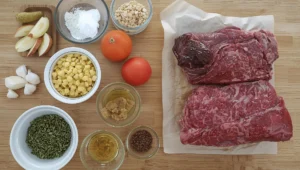
Tender Korean beef ribs with sesame glaze over steamed rice
Subtopic 1: Essential ingredients
Core components (5–7 items):
Beef (thinly sliced, preferably rib eye, sirloin, or flank)
Soy sauce (for umami and salt)
Sesame oil (for nutty aroma)
Garlic (minced, for pungent warmth)
Ginger (minced, for brightness and depth)
Pear juice or Asian pear (or apple) or a small grated pear/apple (for tenderness and subtle sweetness)
Brown sugar or honey (for caramelized glaze)
Optional enrichers (2–3 items) to customize flavor:
Green onions (for freshness and aroma)
Sesame seeds (for garnish and texture)
Black pepper or gochugaru (for a hint of heat)
Quick notes:
If pear juice isn’t available, grated pear or a touch of apple juice can substitute; the fruit helps tenderize and adds a pleasant sweetness.
Use low-sodium soy sauce if you’re watching salt; adjust salt in the marinade as needed.
Subtopic 2: Simple marinade build
Step-by-step marination guide (quick, actionable):
Prepare a marinade base by whisking together soy sauce, sesame oil, minced garlic, minced ginger, and a sweetener (brown sugar or honey) until dissolved.
Add fruit juice or grated pear to introduce subtle sweetness and tenderness; whisk until smooth.
Taste and adjust: aim for a balanced savory-sweet profile with a hint of aromatic warmth. If desired, add a pinch of black pepper or a touch of chili for a gentle kick.
Slice beef uniformly (2–3 mm / 1/8 inch thick if possible) to ensure even marinade uptake and fast, even cooking.
Combine beef and marinade in a bowl or zip-top bag; ensure all pieces are coated. For best results, marinate 30 minutes to 2 hours. Overnight is fine if planning ahead, but avoid excessively long marination for very lean cuts to prevent texture changes.
When ready to cook, discard any excess marinade that’s been in contact with raw beef, or boil the marinade for a couple of minutes if you want to reuse it as a glaze (note: handle carefully to avoid cross-contamination and ensure safety).
Time guidance:
Short marinate: 30 minutes to 1 hour
Medium marinate: 1–2 hours
Overnight: up to 12–16 hours (in the fridge, in a sealed container)
Practical tips:
For the best glaze, reserve a couple of tablespoons of the marinade before adding the raw beef, then use it to brush on during the final sear.
If using meat with more connective tissue, a slightly longer marination can help flavor penetrate, but avoid over-marinating lean cuts which can become mushy in some marinades.
Optional enhancements and variants
Marinade flexibility: The base concept works with different protein cuts (thinly sliced beef, chicken thighs, or even pork), adjusting marination time accordingly.
Flavor boosters: A splash of rice wine vinegar or a teaspoon of mirin can add a subtle acidity or depth if desired.
Accessibility notes: For quicker weeknight versions, you can use store-bought bulgogi sauce as the base, then augment with garlic, ginger, and a touch of pear for tenderness.
How to cook this Korean beef recipe (bulgogi-style)
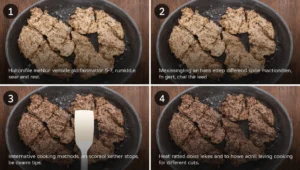
Bulgogi beef cooking in a skillet, caramelizing in a flavorful sauce and ready to be served.
Subtopic 1: Step-by-step method
Step 1: Prep and marinate
Thinly slice beef into uniform pieces (2–3 mm / about 1/8 inch thick) for quick, even cooking.
Whisk together a bulgogi-inspired marinade: soy sauce, sesame oil, minced garlic, grated ginger, brown sugar or honey, and a grated Asian pear or pear juice. Optionally add a splash of rice wine or mirin for acidity and depth.
Combine beef with marinade in a large bowl or resealable bag. Ensure all pieces are well coated. Marinate for 30 minutes to 2 hours for weeknight meals; up to 12–16 hours for deeper flavor.
Step 2: Preheat your cooking surface
Heat a heavy skillet (cast iron or carbon steel) over high heat until very hot, or preheat a grill to high heat. A hot surface is essential to achieve a quick sear and caramelization.
Step 3: Cook in batches
Add a single layer of beef (and any sliced onions if using) to the hot pan. Do not overcrowd; cook in batches to maintain high heat.
Sear for 2–3 minutes per side, or until the edges are deeply browned and the inside remains tender. Avoid overcooking; Bulgogi is quick-cooked to preserve juiciness.
Step 4: Glaze and rest
If you reserved some marinade for a glaze, brush it on during the last 30–60 seconds of cooking for a glossy finish.
Remove from heat and let the meat rest for 1–2 minutes to reabsorb juices.
Step 5: Finish and plate
Finish with a light sprinkle of sesame seeds and sliced green onions for color and crunch.
Serve with steamed rice, kimchi, and optional lettuce wraps or a quick veggie side to create complete bowls.
Subtopic 2: Alternative cooking methods and tips
Skillet vs grill
Skillet (pan-sear): Use a well-seasoned cast iron or heavy-duty stainless skillet. Maintain very high heat, work in small batches, and avoid crowding to keep a proper sear.
Grill: A hot charcoal or gas grill adds a smoky edge. Grill slices quickly over direct high heat, flipping once for even charring. If using a grill, you can thread meat onto skewers for easy handling.
Heat management and timing
For ultra-thin slices, cooking time can be as short as 1–2 minutes per side; for slightly thicker slices, aim for 2–3 minutes per side.
Keep pan temperature high and avoid adding cold meat directly from the fridge; if possible, let sliced beef come to room temperature for a few minutes before cooking to promote even searing.
Cuts and prep variations
Best cuts: rib eye, sirloin, or flank steak sliced very thinly against the grain.
Leaner cuts work well with a touch more marinade time to ensure flavor absorption; fatter cuts stay tender with shorter marination.
Quick marinade options for time-crunched cooks
Use store-bought bulgogi sauce as a base, then enhance with fresh garlic, ginger, and a splash of pear juice to mimic authentic depth.
If pear juice isn’t available, use a small amount of apple juice and a pinch of baking soda to aid tenderness, tested in some home versions (use sparingly and rinse after marinating if you plan to cook immediately).
Health and safety notes
Do not reuse raw-marinated marinade without bringing it to a boil for at least 1–2 minutes if you intend to use it as a glaze.
Refrigerate marinating beef promptly and discard any leftovers that touched raw meat.
Inline tips and flavor boosters
Flavor boosters to consider adding a touch of: gochugaru or crushed red pepper for subtle heat, a dash of rice vinegar for brightness, or a tiny amount of sesame oil finish for extra aroma.
Garnish ideas: sliced green onions, toasted sesame seeds, a light squeeze of lime or lemon over the finished dish to brighten flavors if desired.
Serving ideas, variations, and how this Korean beef recipe fits into a weeknight menu
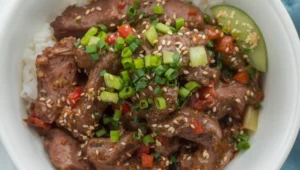
Bulgogi served with fresh toppings and variations to elevate the presentation.
Subtopic 1: Serving options
Rice bowls: Spoon the beef over steamed white or brown rice, with a light drizzle of any pan glaze remaining from cooking. Garnish with sliced green onions and a scatter of sesame seeds for color and aroma.
Lettuce wraps (ssam): Use large butter lettuce leaves as wrappers; add beef, a bit of kimchi, cucumber matchsticks, and a dab of gochujang or a mild chili paste for contrast. The wraps provide a fresh, crunchy counterpoint to the rich beef.
Kimchi sides: Pair with a crisp, tangy kimchi or radish kimchi to balance the sweet-savory glaze and add a probiotic, palate-cleansing note.
Garnishes and finishing touches: Finish with sesame seeds, chopped scallions, and a light squeeze of lime or lemon to brighten the dish if desired.
Meal-building ideas: Turn into bulgogi bowls by adding quick-pickled vegetables, sautéed spinach, or sautéed mushrooms to create a balanced, colorful plate.
Subtopic 2: Variations and substitutions
Protein substitutions: Use thinly sliced chicken thigh, pork shoulder, or even firm tofu for a bulgogi-inspired dish; marination times can be adjusted to suit the protein’s density.
Sweetness and heat adjustments: Increase or reduce sugar to suit taste; add a small amount of gochujang or gochugaru for gentle heat, balancing with a touch more soy or fruit juice to maintain glaze flow.
Make-ahead options: Marinate the beef for 1–2 hours or overnight for deeper flavor, then cook quickly on a hot pan. The ready-to-cook beef can be stored in the fridge for up to 24 hours before cooking.
Kid-friendly tweaks: Reduce heat, skip extra chili, and use a milder glaze; offer a side sauce (e.g., plain soy glaze) for dipping to help younger palates adjust.
Gluten considerations: If using gluten-free soy sauce or tamari, confirm all marinades and any added sauces comply with gluten-free guidelines.
Make-ahead and storage tips:
Marinated beef can be stored in the fridge for up to 24 hours before cooking.
Cooked bulgogi can be cooled and refrigerated for up to 3–4 days or frozen for longer storage.
Reheat gently in a skillet over medium heat with a splash of water or broth to prevent drying.
Optional depth additions (if you want extra richness)
Flavor pairing notes: Suggest complementary flavors like a quick sesame-ginger dressing for salads or a simple cucumber kimchi as a fresh side.
Quick sauce idea: A small drizzle of leftover pan juices simmered briefly with a touch of rice vinegar or lemon juice can become a glossy finishing sauce for bowls.
Practical tips for weeknight optimization
Time-saving sequencing: While marinating (even briefly), prep sides and assemble bowls so that when marination is complete, the beef can be seared and plated within minutes.
Batch cooking strategy: If cooking for a crowd, sear in batches and keep finished beef warm in a low oven while you complete the rest of the meal; re-toss with glaze just before serving to refresh the coating.
Presentation emphasis: A visually appealing plate helps with engagement—arrange rice, beef, greens, and toppings in distinct bands or sections to create vibrant, Instagram-friendly bowls.
FAQ: 3 common questions
Can I use a different cut of beef?
Yes. The bulgogi-style method works best with thinly sliced, tender cuts like ribeye, sirloin, or flank. Leaner cuts will still take on flavor, but you may need a slightly longer marination and careful watch during cooking to avoid drying out. If you only have a tougher cut, consider a light marination with a touch of pineapple or pear to aid tenderization, and cook quickly over high heat to preserve juiciness.
How long can I marinate?
For best flavor, aim for 30 minutes to 2 hours for weeknight cooking. If time allows, 4–6 hours yields stronger depth, and overnight marination (up to 12–16 hours) is excellent for maximum flavor, especially with tender cuts. Avoid marinating for too long if the marinade contains highly acidic components, which can start to break down the meat too much and alter texture.
Can I freeze the marinated beef?
Yes. You can freeze the marinated beef in a sealed bag or container for up to 2–3 months. Thaw in the refrigerator overnight before cooking. If you’ve already marinated and want to freeze, consider freezing only the meat (without the marinade) or freezing after a brief initial marination and then finishing the marinade after thawing to prevent texture changes.
Quick nutrition snapshot (optional)
Per serving (estimates will vary by cut and exact marinade):
Calories: 250–350 kcal
Protein: 26–32 g
Carbohydrates: 10–15 g (mostly from marinade sugar and any added sauce)
Fat: 12–20 g (depends on beef cut and marbling)
Notes:
If you’re tracking macros, adjust by choosing leaner cuts and reducing added sugar or using a sugar substitute. When including sides (rice, kimchi, veggie bowls), total meal macros will shift accordingly.
Cooking science sidebar (two to three sentences)
Why enzymatic marination and sugar-based glaze matter: Enzymatic components in fruit (such as pear juice) help tenderize connective tissue, increasing juiciness. Sugar in the glaze promotes Maillard browning during high-heat searing, resulting in a richer crust and more complex flavor. Together, these elements create the signature bulgogi finish that’s both deeply flavorful and visually appealing.
Tips for integrating into your H2 sections
FAQ box: Present these three questions as a compact FAQ at the bottom of the “Cooking method” section or the “Ingredients and marination” section to address reader concerns without breaking the flow.
Nutrition box: Place a small, non-intrusive nutrition note right after the marination and cooking steps to help readers who track intake, while keeping the main narrative uncluttered.
Cooking science note: Add a short aside near the marinade or glaze step explaining why pear juice helps tenderness and why a hot pan is critical for a quick sear. This adds educational value without overwhelming readers.
Optional depth adds (for higher engagement)
Make-ahead and meal-prep tips: Highlight a plan for marinating earlier in the day or the day before, then cooking quickly in the evening. Emphasize how this fits a busy weeknight schedule.
Substitution cheat sheets: Provide quick swaps for dietary needs (gluten-free soy sauce or tamari, different sweeteners, or alternative aromatics like shallots).
Pairing pointers: Suggest a few quick side dish options (steamed greens, pickled vegetables, or a simple cucumber salad) that complement the beef’s sweet-savory glaze and help round out the meal.
Comprehensive Bulgogi recipe overview
A well-trafficked, authoritative source with step-by-step methods and common substitutions.

